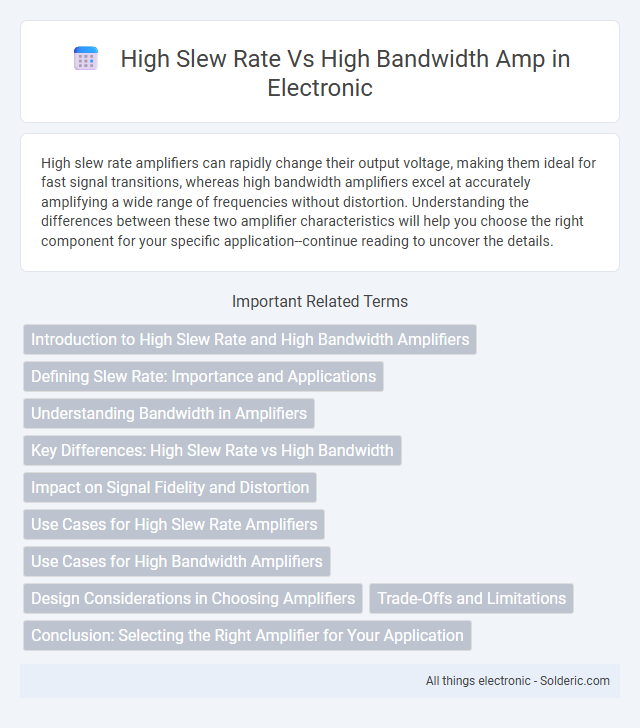High slew rate amplifiers can rapidly change their output voltage, making them ideal for fast signal transitions, whereas high bandwidth amplifiers excel at accurately amplifying a wide range of frequencies without distortion. Understanding the differences between these two amplifier characteristics will help you choose the right component for your specific application--continue reading to uncover the details.
Comparison Table
| Feature | High Slew Rate Amplifier | High Bandwidth Amplifier |
|---|---|---|
| Definition | Amplifier with fast output voltage change rate (V/us) | Amplifier capable of wide frequency response (Hz to GHz) |
| Key Parameter | Slew Rate (typically >10 V/us) | Bandwidth (typically MHz to GHz range) |
| Use Case | Fast transient response, high-speed signal amplification | High-frequency signal processing, RF applications |
| Performance Focus | Minimizing signal distortion in rapid voltage changes | Maintaining gain over wide frequency range |
| Typical Applications | Audio, video, pulse circuits, data converters | RF amplifiers, communication systems, oscilloscopes |
| Limitations | May not guarantee wide frequency response | May have slower output voltage transitions |
Introduction to High Slew Rate and High Bandwidth Amplifiers
High slew rate amplifiers can rapidly change output voltage, making them ideal for high-frequency and fast transient response applications. High bandwidth amplifiers maintain signal integrity across a wide frequency range, ensuring accurate amplification of high-frequency signals. Selecting between high slew rate and high bandwidth depends on the specific requirements for speed and frequency range in electronic circuit design.
Defining Slew Rate: Importance and Applications
Slew rate refers to the maximum rate of change of an amplifier's output voltage per unit time, typically expressed in volts per microsecond (V/us), and is crucial in high-speed signal processing to prevent output distortion. High slew rate amplifiers are essential in applications like video signal amplification and fast data acquisition systems where rapid voltage transitions are common. Compared to high bandwidth amplifiers which focus on frequency response, slew rate directly impacts the amplifier's ability to accurately reproduce fast transient signals without slew-induced distortion.
Understanding Bandwidth in Amplifiers
Bandwidth in amplifiers defines the range of frequencies an amplifier can effectively process without significant signal attenuation, crucial for maintaining signal integrity in high-frequency applications. A high bandwidth amplifier allows accurate amplification of rapidly changing signals, ensuring minimal distortion and preserving the waveform's shape across the frequency spectrum. Understanding bandwidth involves analyzing the amplifier's frequency response curve, where a wider bandwidth corresponds to better performance in audio, communication, and measurement systems requiring faster signal transitions.
Key Differences: High Slew Rate vs High Bandwidth
High slew rate amplifiers excel in rapidly changing signal environments by minimizing output distortion during fast transient responses, ensuring clean signal transitions. High bandwidth amplifiers, on the other hand, maintain signal integrity over a wide frequency range, enabling accurate amplification of high-frequency components without attenuation. Understanding the key differences between the two helps you select the right amplifier based on whether your application prioritizes fast signal change handling or broad frequency response.
Impact on Signal Fidelity and Distortion
High slew rate amplifiers maintain signal fidelity by accurately reproducing rapid voltage changes, reducing distortion in high-frequency, fast transient signals. High bandwidth amplifiers handle a wider range of frequencies, preserving signal integrity across a broad spectrum but may exhibit greater distortion if slew rate limits are insufficient. Optimizing both slew rate and bandwidth is crucial for minimizing distortion and achieving precise signal reproduction in high-speed applications.
Use Cases for High Slew Rate Amplifiers
High slew rate amplifiers excel in applications requiring rapid voltage changes, such as high-speed data acquisition, video signal processing, and pulse or square wave amplification. They are critical in systems where signal integrity during fast transient events is essential, including oscilloscope front-ends and RF communication circuits. High slew rate ensures accurate reproduction of fast edges and minimizes distortion in high-frequency signals despite moderate bandwidth limitations.
Use Cases for High Bandwidth Amplifiers
High bandwidth amplifiers are essential in applications such as radio frequency (RF) communications, high-speed data acquisition, and video signal processing where rapid signal changes over a wide frequency range must be accurately amplified. These amplifiers ensure minimal signal distortion and maintain fidelity in systems requiring fast response times up to several gigahertz. Common use cases include spectrum analyzers, oscilloscopes, and wireless communication devices demanding precise high-frequency performance.
Design Considerations in Choosing Amplifiers
Design considerations in choosing amplifiers focus on the application's frequency response and transient performance requirements; high slew rate amplifiers excel in fast-changing signal environments, minimizing distortion during rapid voltage changes. High bandwidth amplifiers prioritize wide frequency range fidelity, essential for high-frequency signal amplification without attenuation. Evaluating the trade-offs between slew rate and bandwidth ensures optimal amplifier performance in precision analog and high-speed communication systems.
Trade-Offs and Limitations
High slew rate amplifiers excel in rapid voltage change handling, ideal for fast transient signals, but often sacrifice bandwidth and increase power consumption. High bandwidth amplifiers provide extensive frequency range, supporting wide signal spectra, yet may exhibit lower slew rates, limiting performance in fast signal transitions. Your choice depends on balancing speed and frequency response for optimal signal integrity in specific applications.
Conclusion: Selecting the Right Amplifier for Your Application
High slew rate amplifiers excel in applications requiring rapid voltage changes and precise transient response, while high bandwidth amplifiers handle wide frequency ranges and maintain signal integrity at high speeds. Your choice depends on whether speed of voltage change or frequency response is more critical to your specific application, such as high-speed data acquisition or RF signal processing. Evaluating both parameters ensures the optimal amplifier delivers accurate, reliable performance tailored to your system's demands.
High slew rate vs High bandwidth amp Infographic

 solderic.com
solderic.com